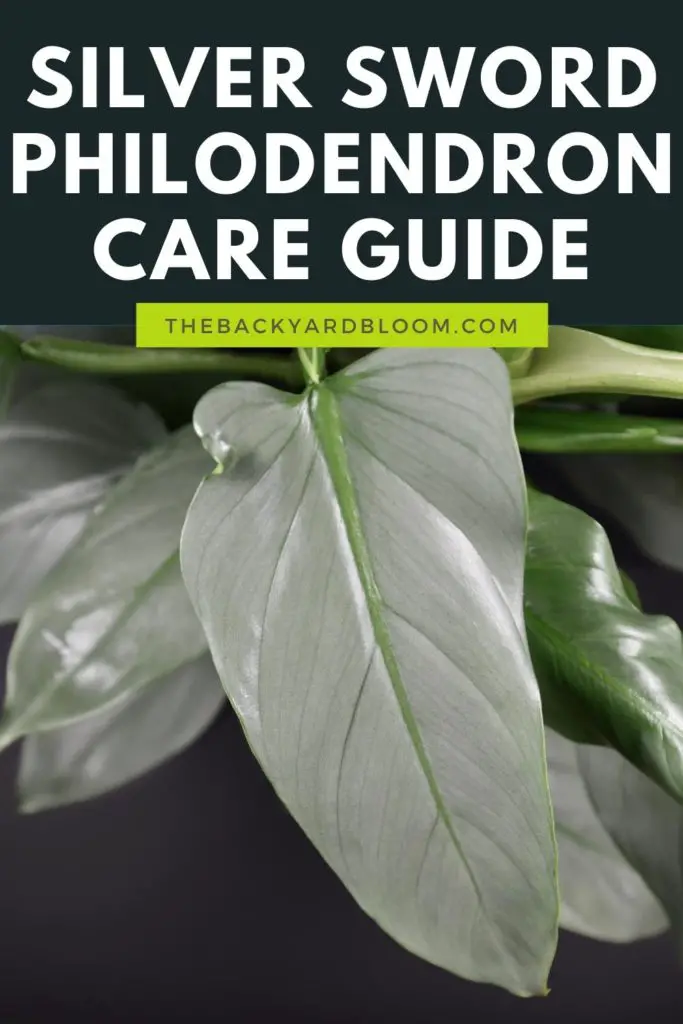Please note that this post may contain affiliate links. You can read my full affiliate disclosure at the bottom of the page.
The Silver Sword Philodendron is named after its leaves that come to a point, resembling a sword shape, and their glossy silver color. It grows in a vine-like fashion that can climb up a stake or up a trellis as it grows and grow up to ten feet in length. They make a beautiful addition to a houseplant collection with their unique color and ability to grow and climb. While some Philodendrons are easy to care for, the Silver Sword can be a bit harder to care for. This can cause some new owners to get nervous or potential owners to choose a different type of Philodendron. Luckily it isn’t hard to provide the care that the Silver Sword needs, you just need to be diligent. In this plant care guide, we go over how to care for your Silver Sword Philodendron so it can grow and thrive in your home.
- Origins of the Silver Sword Philodendron
- Other Names for Silver Sword Philodendron
- Plant Care Guide for the Silver Sword Philodendron
- How To Water a Silver Sword Philodendron
- Philodendron Silver Sword Plant Light Requirements
- Philodendron Silver Sword Soil
- The Best Type of Pot for a Silver Sword Philodendron
- Repotting a Silver Sword Philodendron
- Silver Sword Philodendron Plant Propagation
- Fertilizing a Silver Sword Philodendron
- Temperature Needs
- Philodendron Silver Sword Humidity
- Pruning Silver Sword Philodendron Plants
- Silver Sword Philodendron Toxicity and Pets
- Common Problems With Silver Sword Philodendron Plants
- Frequently Asked Questions About Silver Sword Philodendrons
Origins of the Silver Sword Philodendron
Like many Philodendrons, this type is from a tropical climate. Silver Sword Philodendrons are native to southeastern Brazilian rainforests.
While some report that this is an endangered species due to habitat destruction, according to the IUCN Red List it is in the category of least concern. So there are no specific measures that are currently needed for the conservation of the Philodendron hastatum.
Other Names for Silver Sword Philodendron
- Philodendron hastatum
- Philodendron elongatum
- Philodendron hastifolium
- Philodendron glaucophyllum
- Philodendron disparile
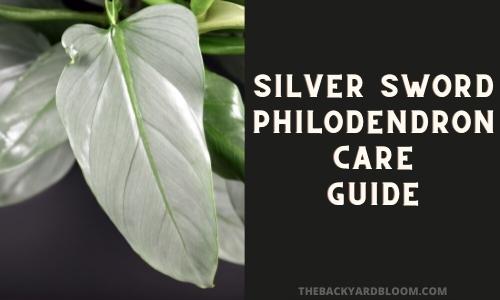
Plant Care Guide for the Silver Sword Philodendron
While Silver Sword Philodendrons are one of the harder-to-find houseplants, they are not too hard to take care of. They are able to adapt to many conditions indoors and won’t be high maintenance as long as you provide the right conditions for the plant.
- Water regularly and do not allow to dry out completely.
- Bright Indirect light.
- Well-draining soil and well-draining pot.
- Fertilize in the spring and summer months.
- Temperatures: 55°F to 90°F.
- Humidity: Above 50%.
- Toxic to pets.
How To Water a Silver Sword Philodendron
Like many tropical plants, Silver Sword Philodendrons love moisture. They need to be watered regularly and not be allowed to completely dry out.
If you have a pot with good drainage water your plant until excess water starts to drain from the bottom of the pot.
You can also use a self-watering pot and allow the pot to sit in water until it soaks up enough water.
One of the great things about Silver Sword Philodendrons and water is that they are able to survive the occasional overwatering. So you do not have to be as rigorous with a watering schedule as some other plants.
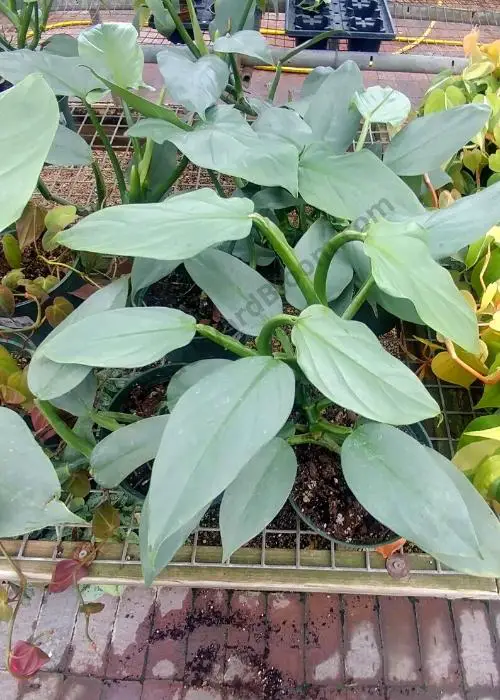
Philodendron Silver Sword Plant Light Requirements
Silver Sword Philodendrons like to have bright indirect light.
While these plants can live in low light or medium light conditions, it is not optimal for them. If you do put your plant in a low light area, it will not grow as well as it would in a brightly lit area.
They do not like direct sunlight. If they are in an area where the sun shines for a good part of the day through a window filter the light with something, such as a sheer curtain. Direct sunlight can cause the foliage to get burned and also fade.
Philodendron Silver Sword Soil
Silver Sword Philodendrons need well-draining soil that also stays moist and aerated.
A good peat-based soil with perlite (What Is Perlite?) to help with draining and aeration will work well for these plants.
Another popular option for a soil medium with plant lovers who have Silver Sword Philodendron is a mix of coco coir, earthworm castings, perlite, and orchid bark. This mixture resembles more of the base that these plants would grow on in the rainforest.
The Best Type of Pot for a Silver Sword Philodendron
Pick a pot that has drainage. Avoid allowing your plant pot to hold on to excess water can lead to root rot which plants have a very hard time recovering from.
Since these are moisture-loving plants do not use Terracotta or unglazed clay pots. These types of pots dry out the soil fast.
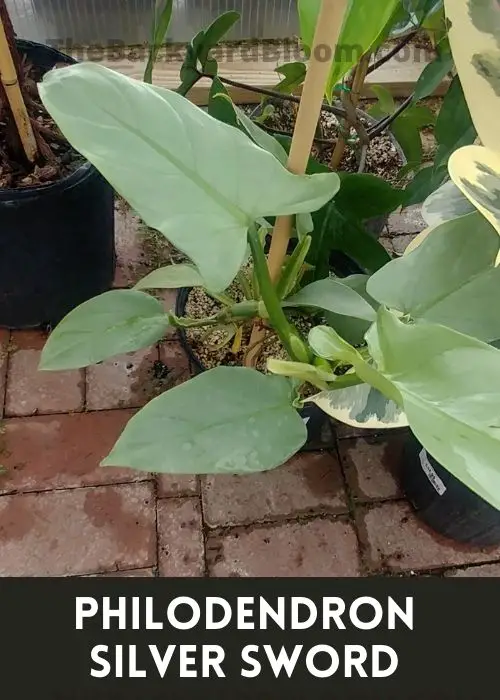
Repotting a Silver Sword Philodendron
Silver Swords need to be repotted once you see the roots starting to grow out of the pot.
Find a pot that is a couple of inches bigger than the current pot. When you repot make sure to check the root ball for any signs of rot or disease. Remove any damage that you find. Give the plant new soil and put it in its new pot.
Silver Sword Philodendron Plant Propagation
Using stem cuttings is the best way to propagate a Silver Sword Philodendron. They are a very easy plant to propagate.
To get a cutting, take a clipping from a vine that has several leaves on it. You can then get multiple cuttings from this one stem by cutting between the leaves and leaving a note at the end of the leaf.
Place your cuttings in some water and within a couple of weeks, they should start to grow new roots.
Fertilizing a Silver Sword Philodendron
Silver Sword Philodendrons should be fertilized during the spring and summer, which is their growing season. You do not want to fertilize the plant in the dormant seasons of fall and winter.
It is best to use a liquid fertilizer for houseplants and follow the directions on the bottle. Silver Swords can grow at a pretty fast rate so fertilizing during the growing season is essential for them to thrive.
Temperature Needs
Since these are tropical plants they do not tolerate cold temperatures well and prefer warmer temperatures. Do not let the temperature go below 55°F or above 90°F.
Optimum temperatures would be a range between 65°F and 85°F.
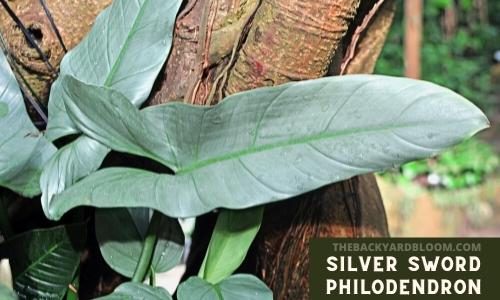
Philodendron Silver Sword Humidity
Like many philodendrons, Silver Swords like high humidity.
Try to keep humidity above 50%, but the higher the better. In the rainforest, these are used to humidity being 85% or higher.
If you find the area where you keep your Silver Sword is getting too low in humidity you can help increase the humidity levels around the plant by grouping it with other plants.
You can also use a pebble tray with water that can increase the humidity around the plant as the water evaporates. This can also help capture run-off water from the plant pot.
Another option that people like to use with plants that like high humidity is to use a humidifier in the room where they keep their tropical plants.
Indoor greenhouse cabinets are becoming a popular thing to use for high humidity plants. By using these you can keep your plants in an area that can be temperature controlled and keep humidity levels in check easily.
Pruning Silver Sword Philodendron Plants
Silver Sword Philodendrons don’t require much for pruning.
Remove any damaged or dead leaves and if the vines are getting too long you can cut them back to a length that suits you best.
Silver Sword Philodendron Toxicity and Pets
The ASPCA shows philodendrons are toxic to pets.
All Philodendrons have calcium oxalate crystals. These crystals are toxic if they are ingested so keep this plant in a place that your pets can’t chew them.
If you do have trouble keeping your pets from munching on your plants you can make a citrus spray with lemon juice to spray on your plants. Bitter Apple spray is another option to use, many pets don’t like the taste or smell.
Common Problems With Silver Sword Philodendron Plants
Mealybugs and Aphids
While Silver Swords aren’t as susceptible to many houseplant pests, mealybugs and aphids can cause issues with them.
Mealybugs look like little white cotton-like fluffs that usually like to hang out on stems right at the node. But they can also be found on the undersides of leaves.
Aphids are also small and like the undersides of leaves and the new growth on the plant. They can be many colors: pale green, yellow, grey, black, red, or pink. You will find them clustered together most often. If the infestation is bad you might find dead ones that have fallen off the plant leaves and be around the outside of the pot.
For either of these pests use insecticidal soap for your best chance of getting rid of them.
Yellow Leaves
Yellow leaves on a Silver Sword Philodendron is usually a sign that the plant is being overwatered.
Allow more time between your waterings and allow your plant to have more time for the soil to dry some.
Curling Leaves
If you have just repotted your Silver Sword curling leaves could just be a normal reaction to the shock that repotting can cause.
If you have not repotted your plant recently or put it in a new location where there was a significant temperature change check the drainage of your pot. Make sure that the pot is allowing drainage of excess water.
Frequently Asked Questions About Silver Sword Philodendrons
At this time Silver Swords are somewhat rare to find in stores. They are picking up in popularity so they might soon become more of a staple in plant shops.
Right now, Etsy is the most popular place to find Silver Sword Philodendrons for sale. You can also check your local plant nurseries. Occasionally people do find them in the big box stores, but that is very rare.
For being one of the houseplants that can be hard to find in stores the price range on Etsy for Silver Sword Philodendrons is not too expensive. It depends on the seller, but most tend to range in the $20 – $50 range.
How often you should water your Silver Sword Philodendron depends on many factors. Humidity, soil medium, temperatures, and the pot that it is in all play a roll in how fast the soil will dry out. You do not want the soil to completely dry out between waterings. This is a plant that prefers to be in moist soil. Just make sure to not allow your plant to sit in soggy soil or old water.
When given the right conditions and given something that its vines can climb, a Silver Sword Philodendron can grow fairly fast. This is especially true when it has good indirect light and the right amount of water. If you keep the plant in lower light conditions or don’t water it well it will not grow very fast.
Yes, Silver Sword Philodendron plants do climb as they grow. These plants grow vines and like to climb upwards as they do in the wild. Giving your plant something for its vines to climb is best. You can use a stick or even a small indoor trellis.
Leaves turning yellow on a Silver Sword Philodendron indicate that the plant is getting too much water. Allow more time between watering the plant if you start to see this happening.
Most often leaves curling on a Silver Sword Philodendron are a result of shock from things such as a change in location or being repotted.
Once you start to see roots growing out of the bottom of the pot, it is time to repot your Silver Sword.
Related Article for Philodendron Silver Sword Care:
- Philodendron Brasil Care Guide
- Philodendron Burle Marx Care Guide and Tips
- Philodendron Melanochrysum Care Guide (Black Gold Philodendron)
